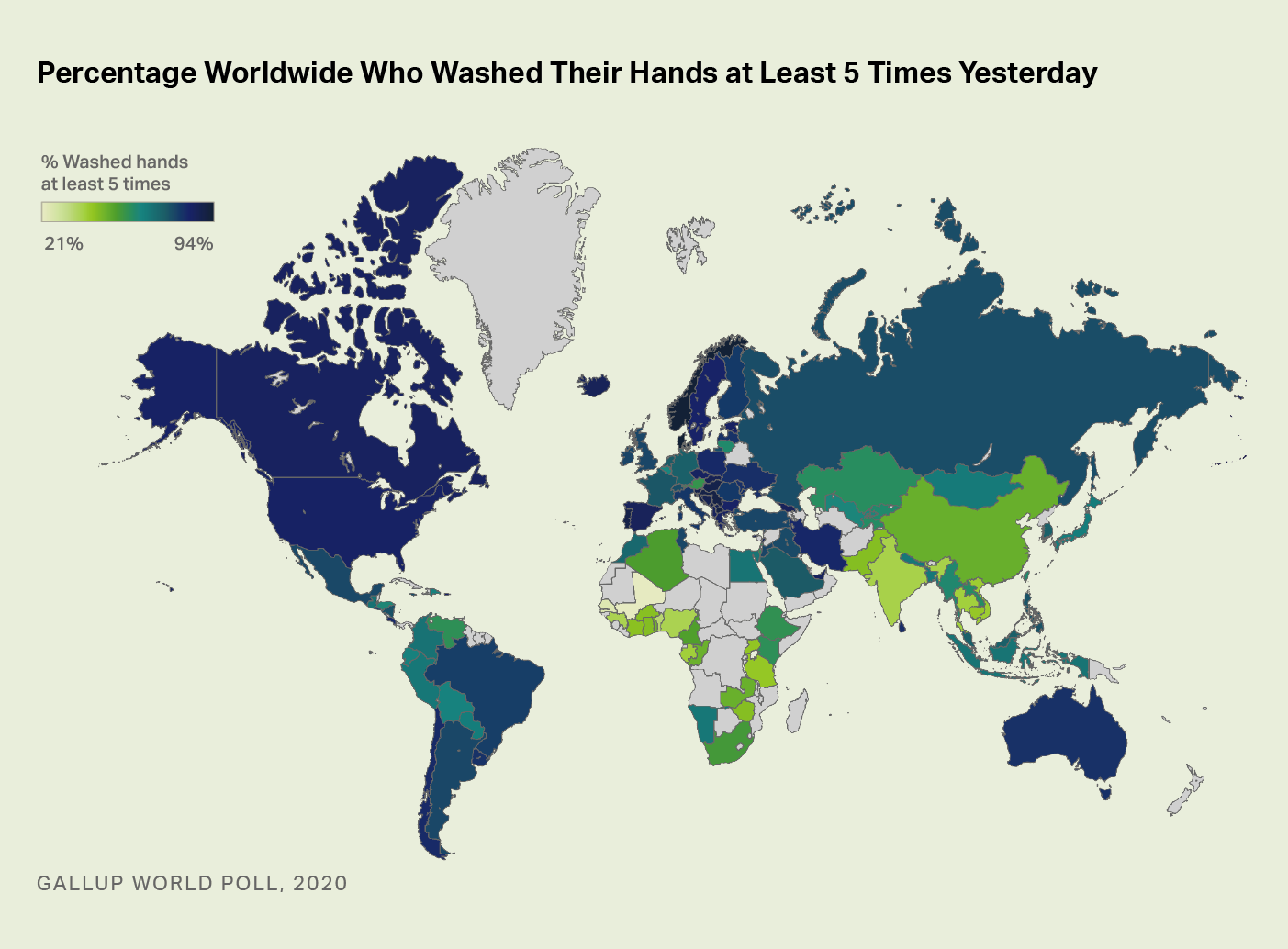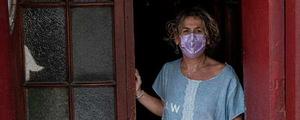Story Highlights
-
58% worldwide report washing their hands at least five times a day
WASHINGTON, D.C. -- Along with getting a COVID-19 vaccine when it is available, practicing social distancing and wearing masks, the U.S. Centers for Disease Control and Prevention (CDC) recommends people wash their hands often -- with soap and water -- to prevent the spread of COVID-19. Although the CDC doesn't define how many times "often" is, five or more times a day likely aligns with the CDC's recommendation.
When asked how many times they washed their hands or used hand sanitizer the previous day, the world's population seems to be complying. The majority of adults (58%) who Gallup surveyed in 118 countries and areas in the latter half of 2020 said they washed their hands with soap and water -- or used hand sanitizer -- five or more times the previous day. Although just 2% of adults worldwide said they did not wash their hands at all the prior day, this would still translate into more than 86 million people.
Worldwide, the percentage of people who wash their hands or use hand sanitizer five or more times a day ranges from a high of 94% in Denmark and Norway to a low of 21% in Mali.

Heat map. The percentage of the population who washed their hands at least five times a day yesterday, by country. This ranges from 21% in Mali to 94% in Denmark and Norway. All of the top 10 countries where populations most likely to engage in handwashing five times a day or more are European - all with high levels or infrastructure development, likely indicating that most of their populations have access to water and handwashing facilities.
| 0 times | 1 time | 2 times | 3 times | 4 times | 5+ times | ||||||||||||||||||||||||||||||||||||||||||||||||||||||||||||||||||||||||||||||||||||||||||||||
|---|---|---|---|---|---|---|---|---|---|---|---|---|---|---|---|---|---|---|---|---|---|---|---|---|---|---|---|---|---|---|---|---|---|---|---|---|---|---|---|---|---|---|---|---|---|---|---|---|---|---|---|---|---|---|---|---|---|---|---|---|---|---|---|---|---|---|---|---|---|---|---|---|---|---|---|---|---|---|---|---|---|---|---|---|---|---|---|---|---|---|---|---|---|---|---|---|---|---|---|
| % | % | % | % | % | % | ||||||||||||||||||||||||||||||||||||||||||||||||||||||||||||||||||||||||||||||||||||||||||||||
| Denmark | 1 | 0 | 1 | 1 | 2 | 94 | |||||||||||||||||||||||||||||||||||||||||||||||||||||||||||||||||||||||||||||||||||||||||||||
| Norway | 0 | 0 | 1 | 2 | 3 | 94 | |||||||||||||||||||||||||||||||||||||||||||||||||||||||||||||||||||||||||||||||||||||||||||||
| Malta | 0 | 0 | 1 | 2 | 4 | 92 | |||||||||||||||||||||||||||||||||||||||||||||||||||||||||||||||||||||||||||||||||||||||||||||
| North Macedonia | 1 | 0 | 1 | 4 | 3 | 91 | |||||||||||||||||||||||||||||||||||||||||||||||||||||||||||||||||||||||||||||||||||||||||||||
| Serbia | 0 | 0 | 1 | 3 | 4 | 91 | |||||||||||||||||||||||||||||||||||||||||||||||||||||||||||||||||||||||||||||||||||||||||||||
| Croatia | 0 | 0 | 1 | 4 | 2 | 90 | |||||||||||||||||||||||||||||||||||||||||||||||||||||||||||||||||||||||||||||||||||||||||||||
| Montenegro | 0 | 1 | 0 | 1 | 6 | 90 | |||||||||||||||||||||||||||||||||||||||||||||||||||||||||||||||||||||||||||||||||||||||||||||
| Portugal | 0 | 0 | 1 | 4 | 4 | 90 | |||||||||||||||||||||||||||||||||||||||||||||||||||||||||||||||||||||||||||||||||||||||||||||
| Hungary | 0 | 1 | 2 | 2 | 4 | 90 | |||||||||||||||||||||||||||||||||||||||||||||||||||||||||||||||||||||||||||||||||||||||||||||
| Slovenia | 0 | 1 | 1 | 4 | 4 | 90 | |||||||||||||||||||||||||||||||||||||||||||||||||||||||||||||||||||||||||||||||||||||||||||||
| Gallup World Poll, 2020 | |||||||||||||||||||||||||||||||||||||||||||||||||||||||||||||||||||||||||||||||||||||||||||||||||||
Those countries with populations least likely to wash their hands five or more times a day are largely clustered in Asia and Africa. For many of the countries where individuals are least likely to say they wash their hands five or more times a day, clean water and handwashing facilities are hard to come by and may involve a several-hour walk to reach them.
For instance, according to 2017 World Health Organization data, almost 9 million people in Mali lacked access to basic hygiene facilities in a country with a population of nearly 20 million. Additionally, in Senegal, where 24% of the population reports washing their hands at least five times a day, roughly 12 million people lacked access to basic hygiene facilities in 2017. In a recent study of handwashing in four Indian states, 33% of those who did not wash their hands said a lack of access to water prevented them from doing so.
| 0 times | 1 time | 2 times | 3 times | 4 times | 5+ times | ||||||||||||||||||||||||||||||||||||||||||||||||||||||||||||||||||||||||||||||||||||||||||||||
|---|---|---|---|---|---|---|---|---|---|---|---|---|---|---|---|---|---|---|---|---|---|---|---|---|---|---|---|---|---|---|---|---|---|---|---|---|---|---|---|---|---|---|---|---|---|---|---|---|---|---|---|---|---|---|---|---|---|---|---|---|---|---|---|---|---|---|---|---|---|---|---|---|---|---|---|---|---|---|---|---|---|---|---|---|---|---|---|---|---|---|---|---|---|---|---|---|---|---|---|
| % | % | % | % | % | % | ||||||||||||||||||||||||||||||||||||||||||||||||||||||||||||||||||||||||||||||||||||||||||||||
| Cambodia | 3 | 4 | 12 | 27 | 7 | 42 | |||||||||||||||||||||||||||||||||||||||||||||||||||||||||||||||||||||||||||||||||||||||||||||
| Vietnam | 4 | 5 | 14 | 23 | 8 | 40 | |||||||||||||||||||||||||||||||||||||||||||||||||||||||||||||||||||||||||||||||||||||||||||||
| Gabon | 5 | 6 | 14 | 19 | 10 | 39 | |||||||||||||||||||||||||||||||||||||||||||||||||||||||||||||||||||||||||||||||||||||||||||||
| Thailand | 2 | 3 | 15 | 29 | 9 | 39 | |||||||||||||||||||||||||||||||||||||||||||||||||||||||||||||||||||||||||||||||||||||||||||||
| India | 3 | 4 | 13 | 19 | 18 | 38 | |||||||||||||||||||||||||||||||||||||||||||||||||||||||||||||||||||||||||||||||||||||||||||||
| Guinea | 5 | 6 | 15 | 20 | 11 | 37 | |||||||||||||||||||||||||||||||||||||||||||||||||||||||||||||||||||||||||||||||||||||||||||||
| Nigeria | 5 | 3 | 13 | 24 | 13 | 37 | |||||||||||||||||||||||||||||||||||||||||||||||||||||||||||||||||||||||||||||||||||||||||||||
| Benin | 6 | 4 | 18 | 22 | 10 | 34 | |||||||||||||||||||||||||||||||||||||||||||||||||||||||||||||||||||||||||||||||||||||||||||||
| Senegal | 13 | 9 | 17 | 21 | 11 | 24 | |||||||||||||||||||||||||||||||||||||||||||||||||||||||||||||||||||||||||||||||||||||||||||||
| Mali | 18 | 9 | 17 | 22 | 10 | 21 | |||||||||||||||||||||||||||||||||||||||||||||||||||||||||||||||||||||||||||||||||||||||||||||
| Gallup World Poll, 2020 | |||||||||||||||||||||||||||||||||||||||||||||||||||||||||||||||||||||||||||||||||||||||||||||||||||
Women Report More Frequent Handwashing Than Men
Across the world, women are substantially more likely than men to report washing their hands five or more times a day (64% vs. 52%, respectively). Additionally, the likelihood of washing one's hands often rises with education level, from 48% among those with a primary education (up to eight years of schooling) to 73% among those with a university or four-year degree.
Those who live in more urbanized areas are more likely to wash their hands at least five times a day. Sixty-three percent of people living in urban areas meet this standard, compared with 54% of those in rural areas. Again, this is likely related to the availability of water, with those in less urbanized areas having less access due to lower levels of water delivery infrastructure. Additionally, at least some of the difference in rural areas may be related to a lack of availability of soap or other disinfectants for handwashing. Individuals in these areas may still be washing their hands, but not using soap or sanitizer.
| 0 times | 1 time | 2 times | 3 times | 4 times | 5+ times | |||||||||||||||||||||||||||||||||||||||||||||||||||||||||||||||||||||||||||||||||||||||||||||||
|---|---|---|---|---|---|---|---|---|---|---|---|---|---|---|---|---|---|---|---|---|---|---|---|---|---|---|---|---|---|---|---|---|---|---|---|---|---|---|---|---|---|---|---|---|---|---|---|---|---|---|---|---|---|---|---|---|---|---|---|---|---|---|---|---|---|---|---|---|---|---|---|---|---|---|---|---|---|---|---|---|---|---|---|---|---|---|---|---|---|---|---|---|---|---|---|---|---|---|---|---|
| % | % | % | % | % | % | |||||||||||||||||||||||||||||||||||||||||||||||||||||||||||||||||||||||||||||||||||||||||||||||
| Overall global | 2 | 3 | 8 | 14 | 10 | 58 | ||||||||||||||||||||||||||||||||||||||||||||||||||||||||||||||||||||||||||||||||||||||||||||||
| Gender | ||||||||||||||||||||||||||||||||||||||||||||||||||||||||||||||||||||||||||||||||||||||||||||||||||||
| Men | 2 | 3 | 9 | 16 | 11 | 52 | ||||||||||||||||||||||||||||||||||||||||||||||||||||||||||||||||||||||||||||||||||||||||||||||
| Women | 1 | 2 | 6 | 12 | 9 | 64 | ||||||||||||||||||||||||||||||||||||||||||||||||||||||||||||||||||||||||||||||||||||||||||||||
| Education | ||||||||||||||||||||||||||||||||||||||||||||||||||||||||||||||||||||||||||||||||||||||||||||||||||||
| Primary (8 years or less) | 2 | 3 | 9 | 17 | 12 | 48 | ||||||||||||||||||||||||||||||||||||||||||||||||||||||||||||||||||||||||||||||||||||||||||||||
| Secondary (9-15 years) | 1 | 2 | 7 | 13 | 10 | 62 | ||||||||||||||||||||||||||||||||||||||||||||||||||||||||||||||||||||||||||||||||||||||||||||||
| University or four-year degree | 1 | 2 | 4 | 10 | 8 | 73 | ||||||||||||||||||||||||||||||||||||||||||||||||||||||||||||||||||||||||||||||||||||||||||||||
| Rural/Urban | ||||||||||||||||||||||||||||||||||||||||||||||||||||||||||||||||||||||||||||||||||||||||||||||||||||
| Rural | 2 | 3 | 9 | 15 | 11 | 54 | ||||||||||||||||||||||||||||||||||||||||||||||||||||||||||||||||||||||||||||||||||||||||||||||
| Urban | 1 | 2 | 6 | 13 | 9 | 63 | ||||||||||||||||||||||||||||||||||||||||||||||||||||||||||||||||||||||||||||||||||||||||||||||
| Gallup World Poll, 2020 | ||||||||||||||||||||||||||||||||||||||||||||||||||||||||||||||||||||||||||||||||||||||||||||||||||||
Bottom Line
For many in highly developed, wealthy countries, the ability to wash one's hands is taken for granted, with most people never more than a short walk from a sink or bathroom. However, for large areas of the developing world, this is simply not the case -- and this lack of access to even the most basic hygiene facilities affects the frequency with which people wash their hands.
Before the COVID-19 pandemic, lack of handwashing was already a serious health concern, with unwashed hands passing along diseases from one individual to another. With the start of the pandemic, the importance of handwashing has taken on increased urgency, as outbreaks of the virus have strained and overwhelmed healthcare systems in even the wealthiest of countries. Many of the countries with the lowest levels of handwashing have the least-developed healthcare infrastructures to deal with these outbreaks, setting up potentially nightmarish scenarios in these countries with COVID-19 cases raging out of control.
Many international and local organizations have deployed COVID-19 prevention campaigns in communities across countries with poor water delivery infrastructures. But the findings underscore the ongoing need to raise people's awareness about the importance of handwashing to combat the pandemic.
For complete methodology and specific survey dates, please review Gallup's Country Data Set details.
Learn more about how the Gallup World Poll works.




